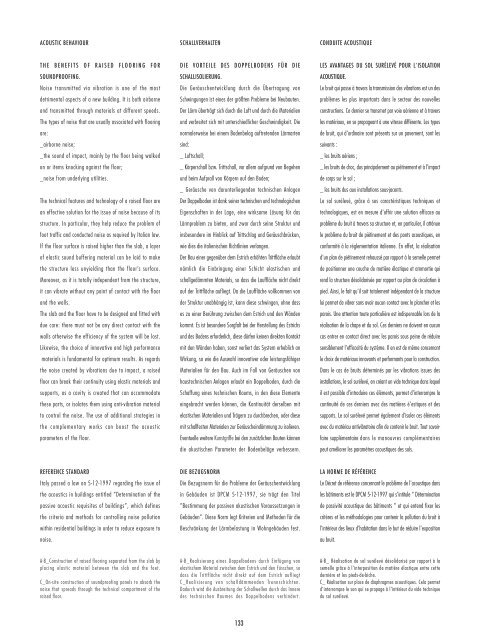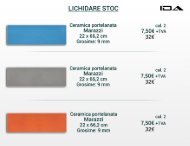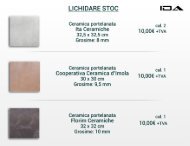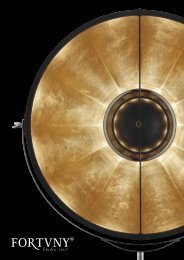Graniti Fiandre - Manualul Inginerului
Create successful ePaper yourself
Turn your PDF publications into a flip-book with our unique Google optimized e-Paper software.
ACOUSTIC BEHAVIOUR<br />
SCHALLVERHALTEN<br />
CONDUITE ACOUSTIQUE<br />
THE BENEFITS OF RAISED FLOORING FOR<br />
SOUNDPROOFING.<br />
Noise transmitted via vibration is one of the most<br />
detrimental aspects of a new building. It is both airborne<br />
and transmitted through materials at different speeds.<br />
The types of noise that are usually associated with flooring<br />
are:<br />
_airborne noise;<br />
_the sound of impact, mainly by the floor being walked<br />
on or items knocking against the floor;<br />
_noise from underlying utilities.<br />
The technical features and technology of a raised floor are<br />
an effective solution for the issue of noise because of its<br />
structure. In particular, they help reduce the problem of<br />
foot traffic and conducted noise as required by Italian law.<br />
If the floor surface is raised higher than the slab, a layer<br />
of elastic sound buffering material can be laid to make<br />
the structure less unyielding than the floor’s surface.<br />
Moreover, as it is totally independent from the structure,<br />
it can vibrate without any point of contact with the floor<br />
and the walls.<br />
The slab and the floor have to be designed and fitted with<br />
due care: there must not be any direct contact with the<br />
walls otherwise the efficiency of the system will be lost.<br />
Likewise, the choice of innovative and high performance<br />
materials is fundamental for optimum results. As regards<br />
the noise created by vibrations due to impact, a raised<br />
floor can break their continuity using elastic materials and<br />
supports, as a cavity is created that can accommodate<br />
these parts, or isolates them using anti-vibration material<br />
to control the noise. The use of additional strategies in<br />
the complementary works can boost the acoustic<br />
parameters of the floor.<br />
DIE VORTEILE DES DOPPELBODENS FÜR DIE<br />
SCHALLISOLIERUNG.<br />
Die Geräuschentwicklung durch die Übertragung von<br />
Schwingungen ist eines der größten Probleme bei Neubauten.<br />
Der Lärm überträgt sich durch die Luft und durch die Materialien<br />
und verbreitet sich mit unterschiedlicher Geschwindigkeit. Die<br />
normalerweise bei einem Bodenbelag auftretenden Lärmarten<br />
sind:<br />
_ Luftschall;<br />
_ Körperschall bzw. Trittschall, vor allem aufgrund von Begehen<br />
und beim Aufprall von Körpern auf den Boden;<br />
_ Geräusche von darunterliegenden technischen Anlagen<br />
Der Doppelboden ist dank seiner technischen und technologischen<br />
Eigenschaften in der Lage, eine wirksame Lösung für das<br />
Lärmproblem zu bieten, und zwar durch seine Struktur und<br />
insbesondere im Hinblick auf Trittschlag und Geräuschbrücken,<br />
wie dies die italienischen Richtlinien verlangen.<br />
Der Bau einer gegenüber dem Estrich erhöhten Trittfläche erlaubt<br />
nämlich die Einbringung einer Schicht elastischen und<br />
schallgedämmten Materials, so dass die Lauffläche nicht direkt<br />
auf der Trittfläche aufliegt. Da die Lauffläche vollkommen von<br />
der Struktur unabhängig ist, kann diese schwingen, ohne dass<br />
es zu einer Berührung zwischen dem Estrich und den Wänden<br />
kommt. Es ist besondere Sorgfalt bei der Herstellung des Estrichs<br />
und des Bodens erforderlich, diese dürfen keinen direkten Kontakt<br />
mit den Wänden haben, sonst verliert das System erheblich an<br />
Wirkung, so wie die Auswahl innovativer oder leistungsfähiger<br />
Materialien für den Bau. Auch im Fall von Geräuschen von<br />
haustechnischen Anlagen erlaubt ein Doppelboden, durch die<br />
Schaffung eines technischen Raums, in den diese Elemente<br />
eingebracht werden können, die Kontinuität derselben mit<br />
elastischen Materialien und Trägern zu durchbrechen, oder diese<br />
mit schallfesten Materialen zur Geräuscheindämmung zu isolieren.<br />
Eventuelle weitere Kunstgriffe bei den zusätzlichen Bauten können<br />
die akustischen Parameter der Bodenbeläge verbessern.<br />
LES AVANTAGES DU SOL SURÉLEVÉ POUR L'ISOLATION<br />
ACOUSTIQUE.<br />
Le bruit qui passe à travers la transmission des vibrations est un des<br />
problèmes les plus importants dans le secteur des nouvelles<br />
constructions. Ce dernier se transmet par voie aérienne et à travers<br />
les matériaux, en se propageant à une vitesse différente. Les types<br />
de bruit, qui d'ordinaire sont présents sur un pavement, sont les<br />
suivants :<br />
_ les bruits aériens ;<br />
_ les bruits de choc, dus principalement au piétinement et à l'impact<br />
de corps sur le sol ;<br />
_ les bruits dus aux installations sous-jacents.<br />
Le sol surélevé, grâce à ses caractéristiques techniques et<br />
technologiques, est en mesure d'offrir une solution efficace au<br />
problème du bruit à travers sa structure et, en particulier, il atténue<br />
le problème du bruit de piétinement et des ponts acoustiques, en<br />
conformité à la réglementation italienne. En effet, la réalisation<br />
d'un plan de piétinement rehaussé par rapport à la semelle permet<br />
de positionner une couche de matière élastique et ammortie qui<br />
rend la structure désolidarisée par rapport au plan de circulation à<br />
pied. Ainsi, le fait qu'il soit totalement indépendant de la structure<br />
lui permet de vibrer sans avoir aucun contact avec le plancher et les<br />
parois. Une attention toute particulière est indispensable lors de la<br />
réalisation de la chape et du sol. Ces derniers ne doivent en aucun<br />
cas entrer en contact direct avec les parois sous peine de réduire<br />
sensiblement l'efficacité du système. Il en est de même concernant<br />
le choix de matériaux innovants et performants pour la construction.<br />
Dans le cas de bruits déterminés par les vibrations issues des<br />
installations, le sol surélevé, en créant un vide technique dans lequel<br />
il est possible d'introduire ces éléments, permet d'interrompre la<br />
continuité de ces derniers avec des matières é'estiques et des<br />
supports. Le sol surélevé permet également d'isoler ces éléments<br />
avec du matériau antivibratoire afin de contenir le bruit. Tout savoirfaire<br />
supplémentaire dans le manouvres complémentaires<br />
peut améliorer les paramètres acoustiques des sols.<br />
REFERENCE STANDARD<br />
Italy passed a law on 5-12-1997 regarding the issue of<br />
the acoustics in buildings entitled “Determination of the<br />
passive acoustic requisites of buildings”, which defines<br />
the criteria and methods for controlling noise pollution<br />
within residential buildings in order to reduce exposure to<br />
noise.<br />
DIE BEZUGSNORM<br />
Die Bezugsnorm für die Probleme der Geräuschentwicklung<br />
in Gebäuden ist DPCM 5-12-1997, sie trägt den Titel<br />
“Bestimmung der passiven akustischen Voraussetzungen in<br />
Gebäuden”. Diese Norm legt Kriterien und Methoden für die<br />
Beschränkung der Lärmbelastung in Wohngebäuden fest.<br />
LA NORME DE RÉFÉRENCE<br />
Le Décret de référence concernant le problème de l'acoustique dans<br />
les bâtiments est le DPCM 5-12-1997 qui s'intitule “ Détermination<br />
de passivité acoustique des bâtiments ” et qui entend fixer les<br />
critères et les méthodologies pour contenir la pollution du bruit à<br />
l'intérieur des lieux d'habitation dans le but de réduire l'exposition<br />
au bruit.<br />
A-B_Construction of raised flooring separated from the slab by<br />
placing elastic material between the slab and the feet.<br />
C_On-site construction of soundproofing panels to absorb the<br />
noise that spreads through the technical compartment of the<br />
raised floor.<br />
A-B_Realisierung eines Doppelbodens durch Einfügung von<br />
elastischem Material zwischen dem Estrich und den Füsschen, so<br />
dass die Trittfläche nicht direkt auf dem Estrich aufliegt<br />
C_Realisierung von schalldämmenden Trennschichten.<br />
Dadurch wird die Ausbreitung der Schallwellen durch das Innere<br />
des technischen Raumes des Doppelbodens verhindert.<br />
A-B_ Réalisation de sol surélevé désolidarisé par rapport à la<br />
semelle grâce à l'interposition de matière élastique entre cette<br />
dernière et les pieds-de-biche.<br />
C_ Réalisation sur place de diaphragmes acoustiques. Cela permet<br />
d'interrompre le son qui se propage à l'intérieur du vide technique<br />
du sol surélevé.<br />
133
















